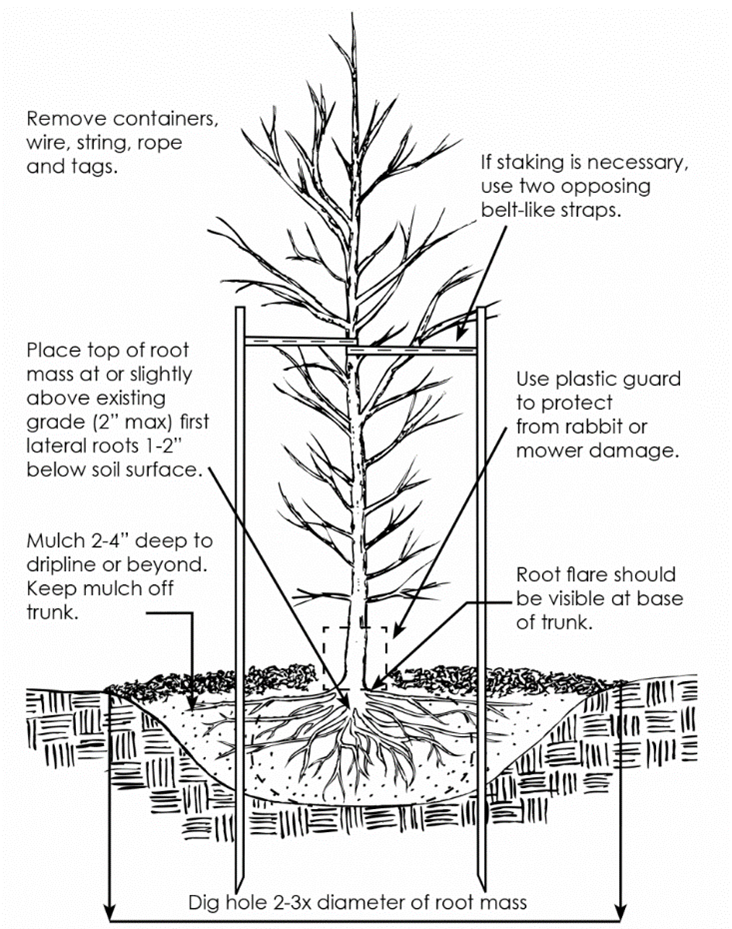Tree and Shrub Planting Guide
Tree & Shrub Planting Guide
Call before you dig! Dial 811
1. Measure the depth of the root ball. Your planting hole should be approximately one inch less in depth than the root ball itself (Example: 14” root ball should be planted in a 13” deep hole). Lay your rake or shovel handle across the hole, the root ball should be just slightly higher than the handle. The tree should sit on undisturbed, firm, soil. You need a firm foundation so the tree doesn’t settle after it is planted.
2. Dig a large saucer shaped hole approximately 3 times the diameter of the root ball (Example: the root ball is 16” across, the diameter of the hole should be 48”). The saucer shaped sides of the planting hole help the new root growth to move outward and upward, away from the trunk or crown. This helps prevent the new roots from girdling the trunk and maintains proper oxygen and nutrient flow to the root system.
3. Gently remove container, for large trees or shrubs, it may be easier to cut the container off. DO NOT pick up the tree or shrub by its trunk and attempt to “shake” off the container.
4. Check the root ball for roots that are growing in a circular pattern. If the roots are “Pot Bound” it is recommended to shave off an inch to an inch and a half of the exterior of the root ball. Use a hand saw to slice off strips from the exterior of the root ball around the perimeter. Prune any remaining circling roots. This has been found to be more effective than vertical slices through the root ball and prevents root girdling of the tree. Do this in several sections around the root ball. This will stimulate the roots to begin growing out of their circulating pattern.
5. Dust the root ball and cut root ends with a mycorrhizae inoculant, such as Mykes, Soil Moist or other product, so that there is good contact with the root system per the product directions. If possible, dampen the root ball to help adhere the dust to the root ball.
6. Place the tree in the hole and backfill with the original soil, remove any large dirt clumps or rocks. Water in the soil to settle it down, do not tamp down. Continue backfilling up to the top of the root ball. If you have any excess soil, use it to build a raised berm around the outside of the hole. This will aid in proper watering. NOTE: If you have heavy clay soil, consult our Nursery Manager. It is NOT recommended to try and adapt trees to soil they cannot tolerate.
7. Mix the Ferti-lome Root Stimulator or Bonide Root & Grow according to the directions on the label. Water the tree or shrub thoroughly with the mixture throughout the first two growing seasons.
8. Add mulch to the planting area, keeping the mulch 4-6 inches from the trunk of the tree or crown of the shrub. This will help retain moisture, moderate the soil temperature and prevent mower/trimmer damage, ensuring a good consistent growing area for your new plant. It looks great too!
9. Large, tall trees will require staking and guying. This will prevent any wind damage that could topple or shift your tree causing severe root damage. Tree straps should be loose to allow the tree to move a little in the wind. Remove tree straps after one year.

RECOMMENDED:
TREE WRAP We highly recommend using tree wrap on any smooth barked /and/ or dark colored tree trunks. Winter sun can cause frost cracking in young trees, especially trees with southwest exposures. Wrapping should be applied around Thanksgiving and removed by April Fools Day or Easter.
TRUNK BARK PROTECTORS The only trees that may not need Deer Guards are those planted behind a 6’ fence that the deer can’t see through; or have thick rough bark! It is never worth risking the damage that deer WILL do! This can also protect against mechanical damage from mowers.
WATERING:
Newly planted trees will need 5-10 gallons of water a week for the first two years until they are established. It is better to water more deeply and infrequently than lightly and frequently. If the soil is still wet a couple of inches down around the root ball, avoid watering.
Don’t forget to Winter Water!! Trees still lose moisture during the dormant period. If there has been no measurable precipitation for over a week and temperatures are above freezing, water lightly once a week, 2-3 gallons. This goes a long way to preventing winter dye-back and root damage!
Back to Blog